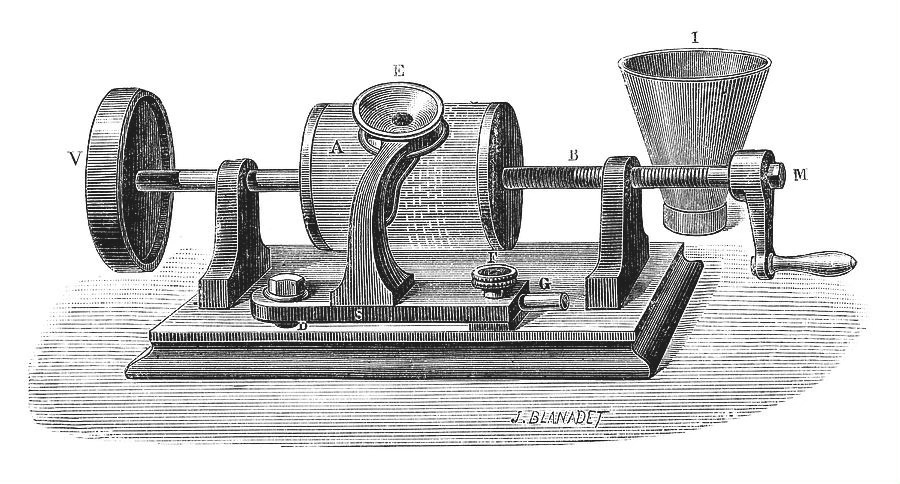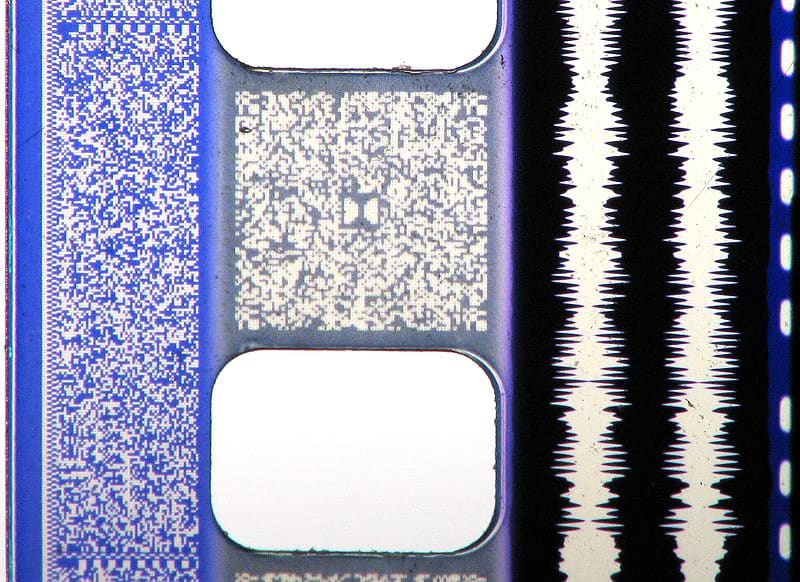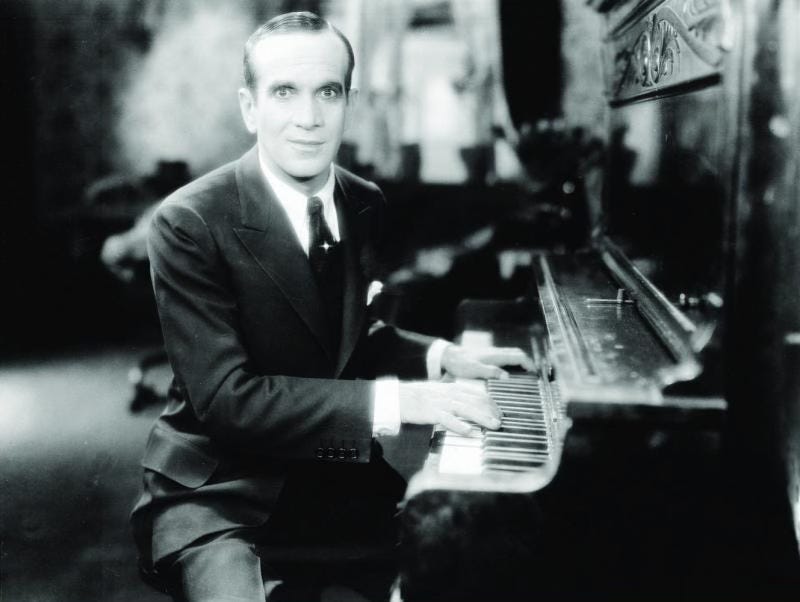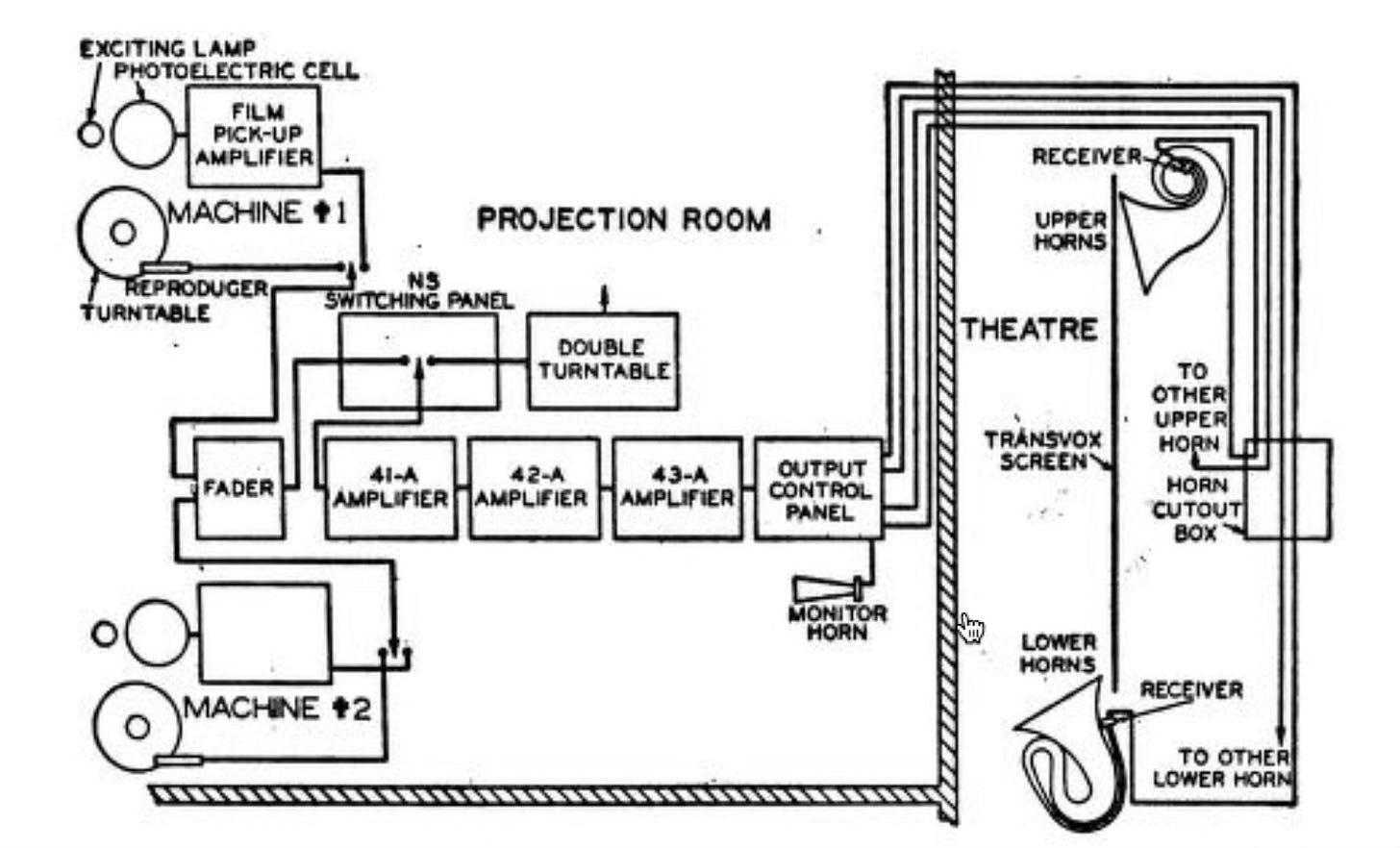Hello and welcome to Popped! A newsletter about the history and culture of cinema.
This week we’re talking Talkies. How they came to be and how Hollywood reacted. It’s a whistelstop tour of this fascinating subject.
Enjoy!
Sound is simply an accessory…The soughing of winds, the ceaseless murmur of waves, the barking of dogs, the crashing of thunder, the roaring of cannons, the sound of an elevated railway outside a window, are important and highly desirable. Add to these, the effective dialogue in dramatic moments, and the usefulness of sound reaches its peak.
The picture remains.
Quality in the picture itself continues to be the dominant object of the producer. Sound becomes important but remains subordinate.
Monta Bell - 19281
In the beginning
Over the course of 100 years, sound on film went from this hand-cranked, tin foil phonograph…
To this…
Multiple sound tracks and digital barcodes for countless speakers, all coded on the side of a still of film:
Today it’s just a file in a folder.
I find this development over the course of the century fascinating. But I’m particularly drawn to the transition from the silent era to the Talkies. A complete modification that created stars and ruined careers across the industry.
Let’s take a look at what happened in the U.S around this time…
You Ain’t Heard Nothing Yet
Two years after Al Jonson uttered those famous words on screen, silent movies seemed completely obsolete.
The Jazz Singer was released in 1927 and by 1929, all but one of the top ten grossing films of that year were sold as Talkies or ‘Part-Talkies’.2
Getting to this stage was not sudden. There had been experimentation for years. From as early as film itself sound had been experimented with. Thomas Edison’s original attempt in 1894 (watch it here) was rudimentary but hugely ground-breaking, before silents were even a thing! Edison’s approach was also impractical. The cylinders could only hold a few minutes of sound and couldn’t really be amplified, let alone be synchronised with the action on screen.
For years audiences would enjoy their films with music accompaniment while the film makers created a silent language. An art form that could be understood the world over, with ways of working behind the camera that naturally develop as people perfect a craft.
Inventing Sound
There were a few issues to solve in order to bring the noise:
How do we record the sound on set?
How do we add that sound on or with the film?
How can the cinema’s play this sound to the audience?
These questions seem unfathomable today don’t they? As I type this, I can count five microphones in my room and three speakers. If only Hollywood knew about my living room…
In terms of adding sound to the film, in the end there were two choices that studios could choose from:
The Tri-Egon System - This system converts sound waves to light waves and records them on to the strip of film itself (this part of the celluloid is known as the soundtrack). The process is then reversed as the film is played.
Vitaphone System - The sound is recorded onto cylinders (essentially vinyl), and synched up to the film through turntables which is clear to see in the following diagram from 1929. 3
Around this time, Warner Brothers weren’t in good shape. They needed to go radical, so did Fox, as they were both not quite as successful as the other studios in town.
Warner Brothers decided to adopt the Vitaphone system, while Fox went with Tri-Egon. They clubbed together to ensure that neither would lose out depending on which version succeeded. (It was the Tri-egon system that won out!)
The big studios knew about the technology available too, but were cautious to invest in the costly upgrades that Warner Brothers were already making. They would keep to the sidelines for now and watch how things unfolded. The success of sound, as well as its artistic merit, were not a given as we see it today.
Though a substantial risk at the time, we all know how things turned out for sound.
It was a phenomenon.
Similar to when Avatar arrived with modern 3D but on a vast scale, every studio wanted in and cinema had to adapt. Studios and picture houses around the world had to upend their businesses, installing equipment, sound stages and speakers with huge up-front costs.
But what about the filmmakers and the actors..how did they adapt? And what did they think?
Adapting & Starting Over
“The placing of the microphone is another problem. We will have to carry microphones concealed under our coats, or suspended on our backs with the wires hanging down our trouser legs. If we find out how to move freely with the concealed micro-phones, we can build a whole runway of wires and establish contact through steel plates on the soles of our shoes”
Harold Lloyd4
The artistic language that filmmakers had developed during the silent era no longer worked. Some carried on with silent movies (Charlie Chaplin being a famous example. But at this stage he was too big to fail), but the box-office numbers spoke for themself.
A lot of us will have seen Singin’ in the Rain with the actor’s struggling and the comical microphone placement. There is a similar set-up in 2022’s Babylon where filming a simple scene quickly descends into madness.
These early Talkie movies were constrained by their many limitations. The microphones were poor, they couldn’t mix sound after recording, the camera was too loud, they needed sound proof sets. The list seemed endlesss. What was a gateway to other worlds suddenly became claustrophobic and stilted.
With rapid advancements in technology, the troubles subsided and by the early 1930’s, full Talkies were being released regularly. Some of the interesting discussions I read were about what kind of movies they would make with this new tech.
Opinion was mixed on using stage plays, with Douglas Fairbanks saying “The screen is different from the stage. On the stage the dialogue works up to a climax which is ended by a curtain. We can't do that on the screen for the simple reason that real life, which the Talkies resemble, has no curtains. My opinion is that stage plays will not be successful on the talking screen”. 5
Sad to remember that the silent picture had an opportunity which it never really developed… films which got a glimpse of vast tracts of open spaces and seas and mountains, and called the very forces of nature, storms and flood and frost and savage beasts to be their actors. But the opportunity for real greatness was scarcely touched, and producers who had the whole world for an arena preferred the easier way — a puppet-show in a closed-in studio.
And now the opportunity has gone. Perhaps there will be another quite as good to take its place — let us hope so, anyway. The king is dead. Long live the king!
Cecil Hepworth 1930
What’s fascinating to me reading opinions around this time is that it all turned out exactly as they wanted it to, but our future was a couple of steps out of reach.
This was a time of experimentation and huge investment, which fortunately came prior to the Great Depression. Famously, actors would lose their jobs with the change. So too would the musicians who had, for years, played along to the silent movies in cinema halls around the world.
Little did they know then that this was one of the last pieces of the puzzle which would secure film’s place in our common culture, and allow an explosion of expression the world over.
Next time…
I will be posting a Further Viewing newsletter for my paid subscribers. This is an extension to my history newsletters where I suggest some videos, documentaries and films to go deeper in to the subject.
If you are interested, a paid subscription supports the work that goes into this newsletter and is the cost of a coffee!
Bell, M. (1928). Movies and Talkies. The North American Review, 226(4), 429–435. http://www.jstor.org/stable/25110592
Interestingly, a lot of this top 10 were also shown in two-tone technicolour. Something that isn’t really talked about around the conversation of this new, talkie era. I presume it’s because this style of colourisation didn’t catch on. It’s another example of the constant innovation of film in those early days.
https://archive.org/details/audels-electric-library-vol-9/page/n473/mode/2up PAGE 474
https://archive.org/details/talkies00john/page/n17/mode/2up .
https://archive.org/details/talkies00john/page/n17/mode/2up (loc.262)








I’d forgotten about this scene in Singin in the Rain 😄 It’s hard to imagine the list of problem-solving they must have been doing in those early days as the equipment was catching up with the needs!
It's worth noting that film studio bosses used the transition to sound to drive down the wages of their stars. They went to all lengths... crying poor about the transition to sound, threatening to end their careers. Those who played ball had their career continue into sound. Those who didn't were defamed with their fans being told they had a terrible voice which people would find ridiculous in the talkies. It's no secret the studio bosses were tight fisted bastards, but sadly a number of the silent stars have had to live with an undeserved reputation because of the way the studio bosses were. This far down the track there is no way to resurrect their reputations unfortunately.